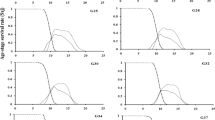Abstract
Understanding thephenology of biological control agents iscritical for developing effective rearingmethods. In the case of Galerucellacalmariensis L, a biological control agentintroduced against purple loosestrife (Lythrum salicaria), the presence of anobligatory diapause affects successful rearing.G. calmariensis individuals were rearedfrom egg to adult under four differentcombinations of long and short photoperiods.Two weeks after adult emergence, individualsfrom each treatment were dissected to check forovary development and presence of developedeggs as indicators of overwintering induction.Individuals treated under short photoperiodthroughout their lifetime were found to havesmaller ovaries and few developed eggs,indicating an effective overwinteringinduction. The adult stage of G.calmariensis was determined to be the stagesensitive to photoperiod, as evidenced byreduction in ovary size, decreasedoverwintering mortality and increasedpost-overwintering fecundity in individualstreated as adults with short daylength. Increased post-overwintering fecundity whendiapause was effectively induced can increasethe efficiency of rearing programs for G. calmariensis and other weed biological controlagents with a reproductive diapause.
Similar content being viewed by others
References
Ali, M.A. and G. Saringer, 1975. Factors regulating diapause in alfalfa ladybird Subcoccinella 24–punctata L. (Col., Coccinellidae). Acta Phythopathology 10: 407–415.
Beck, S.D., 1980. Insect photoperiodism, 2nd edn. Academic Press, New York.
Blossey, B., D. Schoeder, D. Stephen and R.A. Malecki, 1994. Host specificity and environmental impact of two leaf beetles (Galerucella calmariensis and G. pusilla) for biological control of purple loosestrife (Lythrum salicaria). Weed Science 42: 134–140.
Blossey, B. and M. Schat, 1997. Performance of Galerucella calmariensis (Coleoptera: Chrysomelidae) on different North American populations of purple loosestrife. Environmental Entomology 26: 439–444.
Blossey, B. and T.R. Hunt, 1999. Mass rearing methods for Galerucella calmariensis and G. pusilla (Coleoptera: Chrysomelidae), biological control agents of Lythrum salicaria (Lythraceae). Journal of Economic Entomology 92: 325–334.
Danks, H.V., 1987. Insect dormancy: an ecological perspective. Biological survey of Canada Monograph Series Number 1. Ottawa, Canada.
Fraser, B.R. and R.M. Emberson, 1990. Photoperiod and reproductive diapause of the St. John's wort beetle, Chrysolina hyperici. In: E.S. Delfosse (ed), Proceedings of the VII International Symposium on Biological Control ofWeeds, MAF, Rome, Italy. pp. 323–328.
Gomi, T. and M. Takeda, 1992. A quantitative photoperiodic response terminates summer diapause in the tailed zygaenid moth, Elcysma westwoodii. Journal of Insect Physiology 38: 665–670.
Hight, S.D., B. Blossey, J. Laing and R. Declerck-Floate, 1995. Establishment of insect biological control agents from Europe against Lythrum salicaria in North America. Environmental Entomology 24(4): 967–977.
Hodek, I., 1983. Role of environmental factors and endogenous mechanisms in the seasonality of reproduction in insects diapausing as adults. In: V.K. Brown and I. Hodek (eds), Diapause and life cycle strategies in insects, Dr W. Junk Publishers, The Hague, Netherlands.
Kok, L.T., T.J. McAvoy, R.A. Malecki, S.D. Hight, J.J. Drea and J.R. Coulson, 1992. Host specificity tests of Galerucella calmariensis (L.) and G. pusilla (Duft.) (Coleoptera: Chrysomelidae), potential biological control agents of purple loosestrife, Lythrum salicaria L. (Lythraceae). Biological Control 2: 282–290.
Kono, Y., 1982. Change of photoperiodic sensitivity with fat body development during pre-diapause period in the twenty-eight-spotted lady beetle, Henosepilachna vigintioctopunctata Fabricius (Coleoptera: Coccinellidae). Applied Entomology and Zoology 17: 92–101.
Leather, E.R., K.F.A. Walter and J.S. Bale, 1993. The ecology of insect overwintering. Cambridge University Press, Cambridge.
Lefevere, K.S. and C.A.D. De Kort, 1989. Adult diapause in Colorado potato beetle, Leptinotarsa decemlineata: Effects of external factors on maintenance, termination, and postdiapause development. Physiological Entomology 14: 299–308.
Malecki, R.A., B. Blossey, S.D. Hight, D. Schroeder, L.T. Kok and J.R. Coulson, 1993. Biological control of purple loosestrife. BioScience 43: 680–686.
Manguin, S., R. White, B. Blossey and S.D. Hight, 1993. Genetics, taxonomy, and ecology of certain species of Galerucella (Coleoptera: Chrysomelidae. Ann. Entomol. Soc. Am. 86: 397–410.
Mansingh, A., 1971. Physiological classification of dormancies in insects. Canadian Entomologist 103: 983–1009.
McAvoy, T.J., L.T. Kok and W.T. Mays, 1997. Phenology of an establishment of Galerucella calmariensis (L.) and G. pusilla (Duft) (Coleoptera: Chrysomelidae) on purple loosestrife, Lythrum salicaria L. (Lythraceae), in Southwest Virginia. Biological Control 9: 106–111.
Nealis, V., 1985. Diapause and the seasonal ecology of the introduced parasite Cotesia (Apanteles) rubecula (Hymenoptera: Braconidae). Canadian Entomologist 117: 333–342.
Nechols, J.R. 1988. Photoperiodic responses of the squash bug (Heteroptera: Coreidae): diapause induction and maintenance. Environmental Entomology 17: 427–431.
Pullin, A.S. and T.M. Knight, 1992. Induction and termination of reproductive diapause in a neotropical beetle, Chelymorpha alternans (Coleoptera: Chrysomelidae). Journal of Zoology 227: 509–516.
Siew, Y.C., 1965. The endocrine control of adult reproductive diapause in the chrysomelid beetle, Galeruca tanaceti (L) I. Journal of Insect Physiology 11: 1–10.
Tauber, M.J. and C.A. Tauber, 1976. Insect seasonality: Diapause maintenance, termination and postdiapause development. Annual Review of Entomology 21: 81–107.
Tauber, M.J., C.A. Tauber and S. Masaki, 1986. Seasonal adaptations of insects. Oxford University Press, New York.
Tauber, M.J., C.A. Tauber and J.R. Nechols, 1996. Life history of Galerucella nympheae and implications of reproductive diapause for rearing univoltine chrysomelids. Physiological Entomology 21: 317–324.
Taylor, F. and J.B. Spalding, 1988. Fitness functions for alternative developmental pathways in the timing of diapause induction. American Naturalist 131: 678–699.
Tran, B. and J. Huignard, 1993. Changes in responsiveness to factors inducing diapause termination in Bruchus rufinamus (Boh) (Coleoptera: Bruchidae). Journal of Insect Physiology 39: 769–774.
Vinogradova, E.B., G.A. Pantuykhov and N.Y. Bratchikova, 1996. Environmental control of the reproductive diapause in the leaf beetle Zygogramma suturalis F. (Coleoptera: Chrysomelidae). Folia Biologica 44: 67–72.
Voegtlin, D.J. 1995. Potential of Myzus lythri (Homoptera: Aphididae) to influence growth and development of Lythrum salicaria (Myrtiflorae: Lythraceae). Environmental Entomology 24: 724–729.
Author information
Authors and Affiliations
Rights and permissions
About this article
Cite this article
Velarde, R.A., Wiedenmann, R.N. & Voegtlin, D.J. Influence of photoperiod on the overwintering induction of Galerucella calmariensis L. BioControl 47, 587–601 (2002). https://doi.org/10.1023/A:1016597915250
Issue Date:
DOI: https://doi.org/10.1023/A:1016597915250




